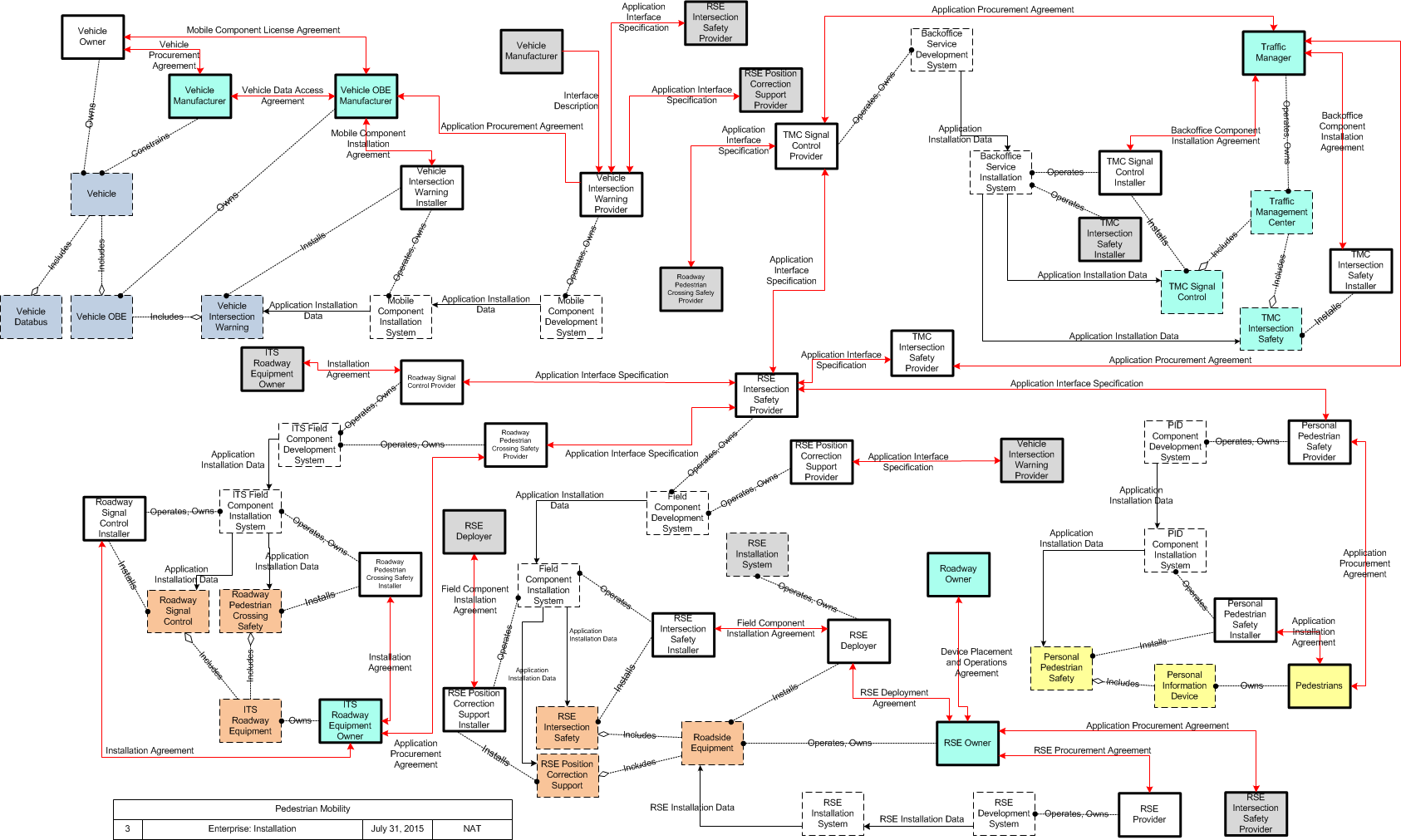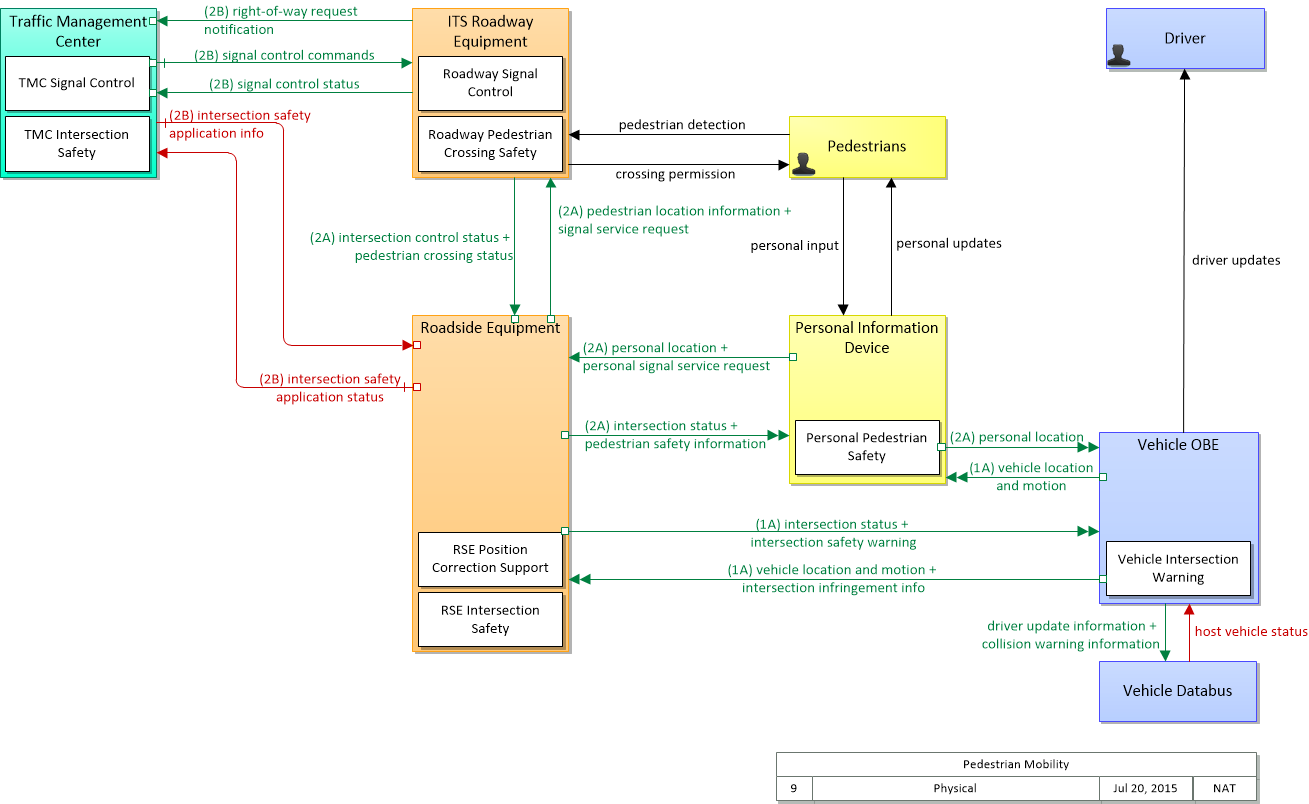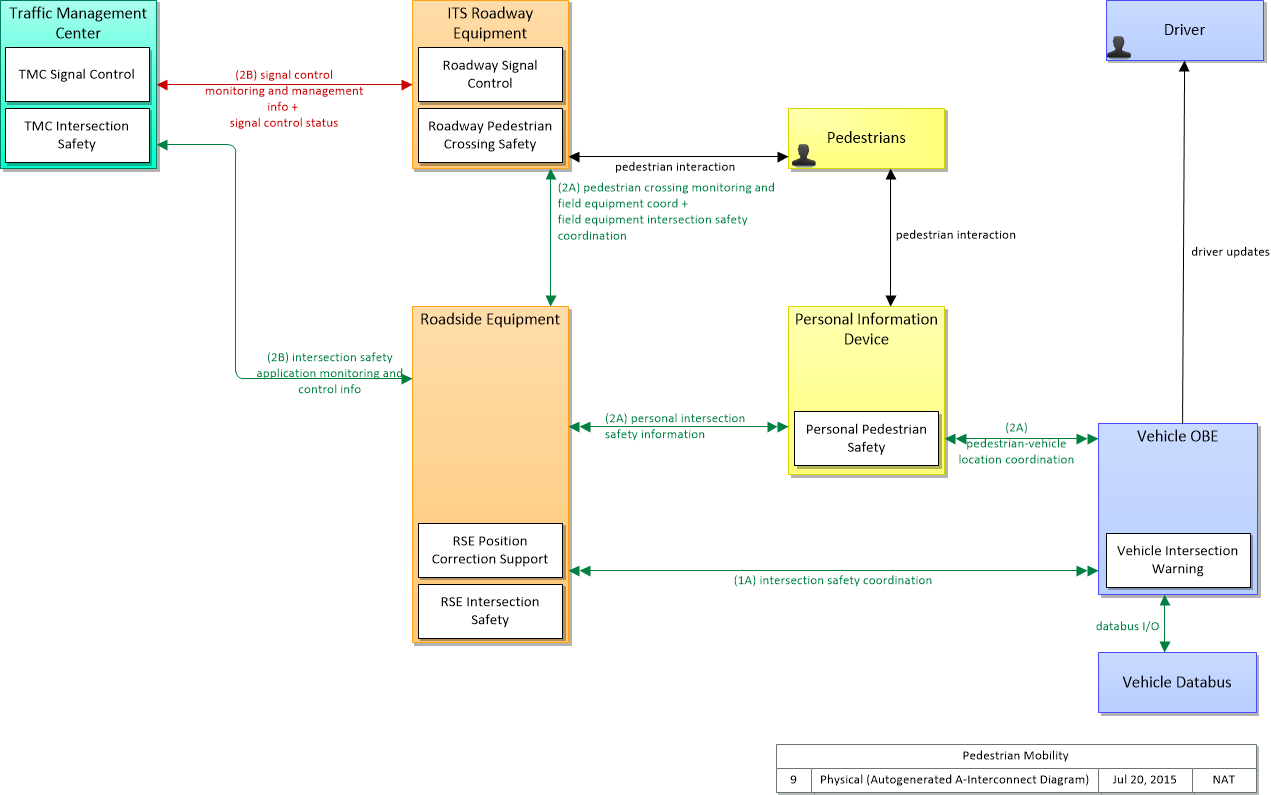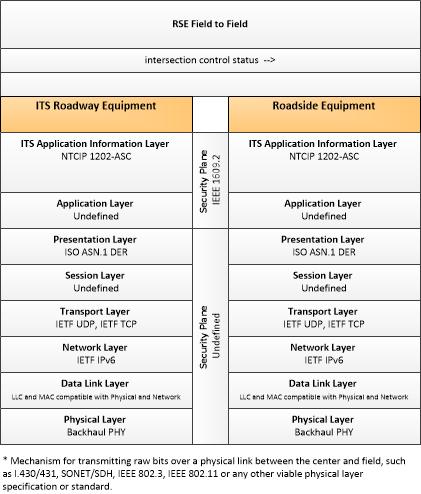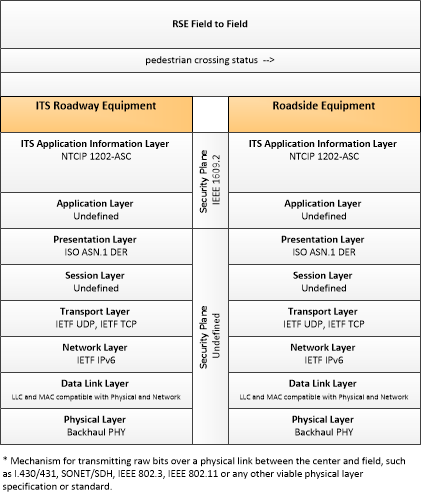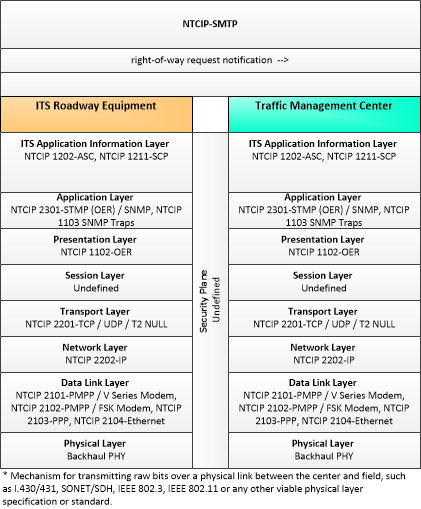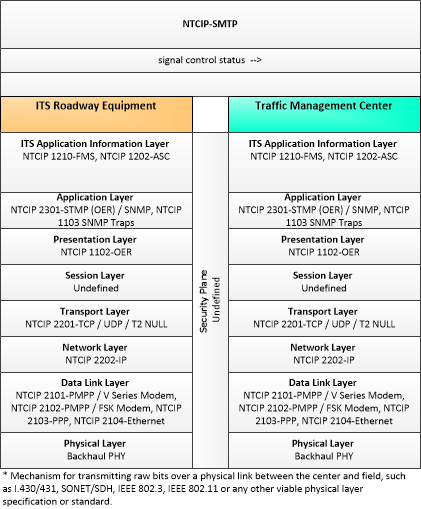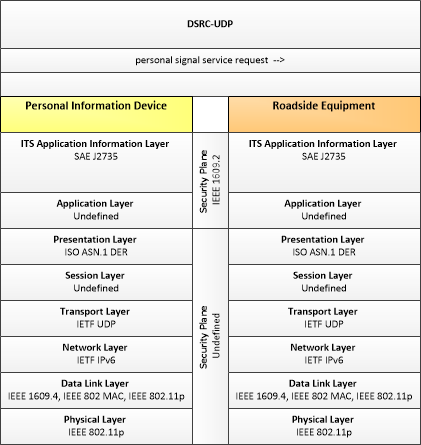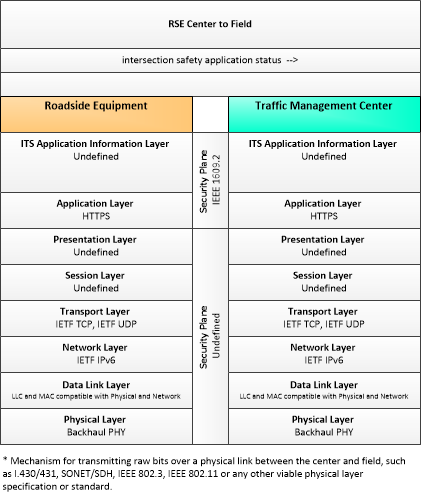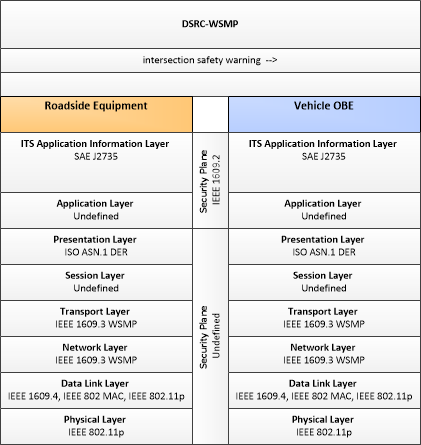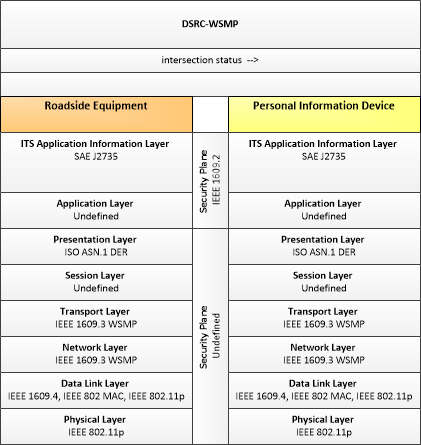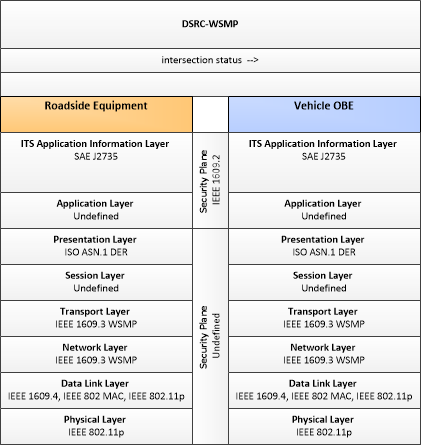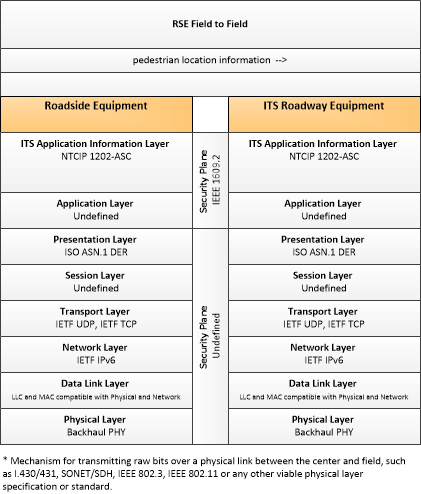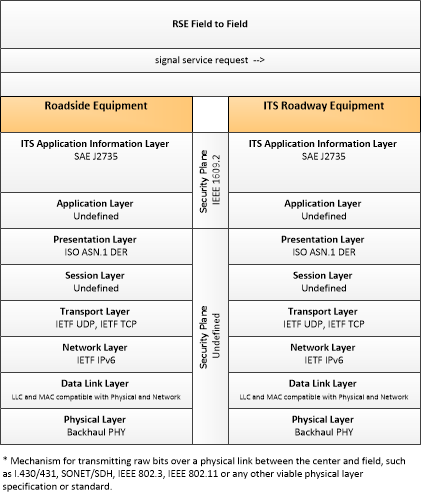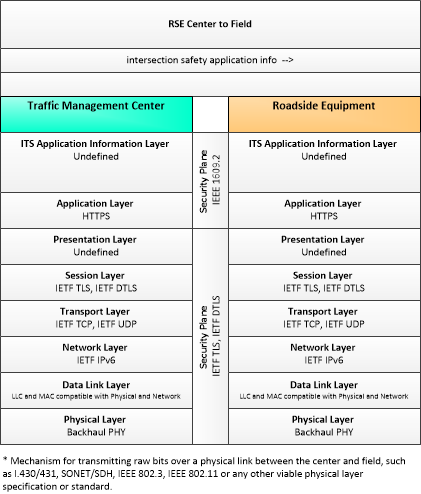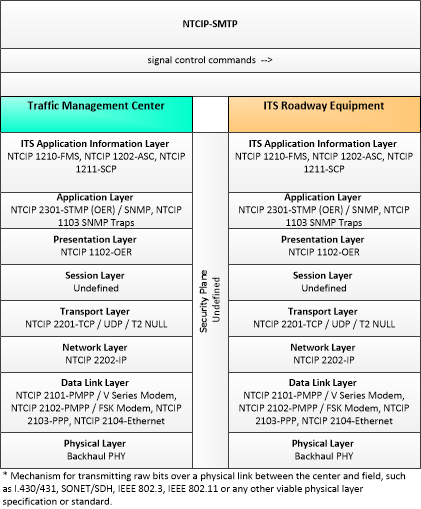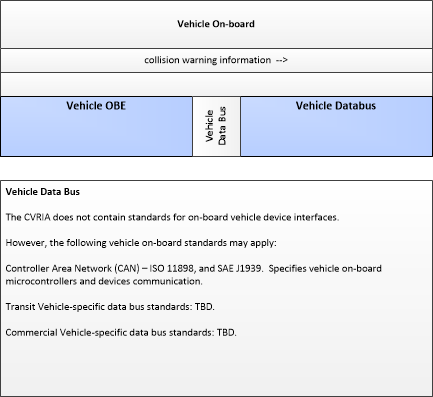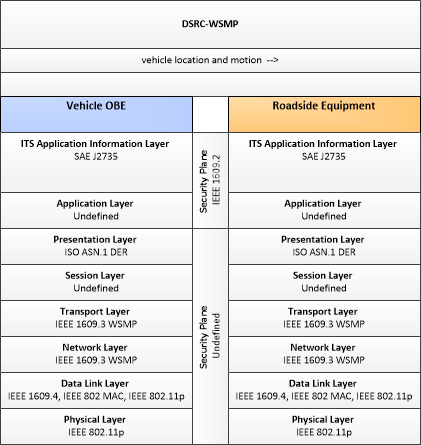Type: Mobility
Groups:- Traffic Signals
Pedestrian Mobility
The Pedestrian Mobility application will integrate traffic and pedestrian information from roadside or intersection detectors and new forms of data from wirelessly connected, pedestrian (or bicyclist) carried mobile devices (nomadic devices) to request dynamic pedestrian signals or to inform pedestrians when to cross and how to remain aligned with the crosswalk based on real-time Signal Phase and Timing (SPaT) and MAP information. In some cases, priority will be given to pedestrians, such as persons with disabilities who need additional crossing time, or in special conditions (e.g., weather) where pedestrians may warrant priority or additional crossing time. This application will enable a "pedestrian call" to be routed to the traffic controller from a nomadic device of a registered person with disabilities after confirming the direction and orientation of the roadway that this pedestrian is intending to cross. The application also provides warnings to the personal information device user of possible infringement of the crossing by approaching vehicles.
Enterprise
SVG Diagrams: Installation Operations Maintenance Certification
PNG Diagrams: Installation Operations Maintenance Certification

Business Interaction Matrix:
| Pedestrian Mobility Operations Stage | ||||||||||||
|---|---|---|---|---|---|---|---|---|---|---|---|---|
| Vehicle Owner | Driver | Vehicle OBE Owner | Roadway Owner | RSE Owner | RSE Operator | ITS Roadway Equipment Owner | ITS Roadway Operator | Traffic Manager | Pedestrians | Vehicle Intersection Warning Provider | RSE Intersection Safety Provider | |
| Vehicle Owner | Vehicle Usage Agreement | Vehicle OBE Usage Agreement | Application Usage Agreement | |||||||||
| Driver | Vehicle Usage Agreement | Expectation of Information Provision | Expectation of Safety Provision | |||||||||
| Vehicle OBE Owner | Vehicle OBE Usage Agreement | Expectation of Information Provision | Expectation of Data Provision | |||||||||
| Roadway Owner | Service Delivery Agreement | |||||||||||
| RSE Owner | Expectation of Data Provision | Service Delivery Agreement | Operations Agreement | Information Exchange and Action Agreement | Information Exchange Agreement | Expectation of Safety Provision | Application Usage Agreement | |||||
| RSE Operator | Operations Agreement | |||||||||||
| ITS Roadway Equipment Owner | Information Exchange and Action Agreement | Operations Agreement | Information Exchange and Action Agreement | |||||||||
| ITS Roadway Operator | Operations Agreement | Expectation of Safety Provision | ||||||||||
| Traffic Manager | Information Exchange Agreement | Information Exchange and Action Agreement | ||||||||||
| Pedestrians | Expectation of Safety Provision | Expectation of Safety Provision | Expectation of Safety Provision | |||||||||
| Vehicle Intersection Warning Provider | Application Usage Agreement | |||||||||||
| RSE Intersection Safety Provider | Application Usage Agreement | |||||||||||
Includes Enterprise Objects:
| Enterprise Object | Description |
|---|---|
| Application Certification Entity | The body that determines whether an application may be deployed and operated in the Connected Vehicle Environment. This entity's composition, the requirements it applies and the procedures it uses to verify those requirements may vary with application type. For example, applications with human safety component (crash avoidance, movement assistance etc.) may have stringent requirements and extensive testing in a variety of conditions, while applications that provide strictly mobility functionality may have far less testing requirements; possibly as little as just making sure the application doesn't interfere with any other applications. |
| Device Certification Entity | The body that determines whether a device may be deployed and operated in the Connected Vehicle Environment. This entity's composition, the requirements it applies and the procedures it uses to verify those requirements may vary with device type. |
| Driver | The 'Driver' represents the person that operates a vehicle on the roadway. Included are operators of private, transit, commercial, and emergency vehicles where the interactions are not particular to the type of vehicle (e.g., interactions supporting vehicle safety applications). The Driver originates driver requests and receives driver information that reflects the interactions which might be useful to all drivers, regardless of vehicle classification. Information and interactions which are unique to drivers of a specific vehicle type (e.g., fleet interactions with transit, commercial, or emergency vehicle drivers) are covered by separate objects. |
| Federal Regulatory | Federal regulatory bodies that have legal authority to control and/or provide input to policies regulating transportation infrastructure and operations. This includes entities such as the Federal Communications Commission and US Department of Transportation. |
| ITS Certification Entity | The body that determines whether an ITS device or application may be deployed and operated in the transportation environment. This entity's composition, the requirements it applies and the procedures it uses to verify those requirements may vary with device and application type. Typically not a formal body, assigned on a project-by-project basis depending on the type of infrastructure involved. Since ITS projects are locally-focused (typically state or smaller), the entities that are part of this body are typically those with operational jurisdiction where the ITS is installed (e.g., state or local DOTs, state or local maintenance managers etc.) |
| ITS Roadway Equipment Owner | The entity that owns the Roadway ITS equipment. |
| ITS Roadway Operator | The entity that operates the Roadway ITS equipment. |
| Pedestrians | 'Pedestrians' participate in connected vehicle applications that support safe, shared use of the transportation network by motorized and non-motorized transportation modes. Representing those using non-motorized travel modes, pedestrians provide input (e.g. a call signal requesting right of way at an intersection) and may be detected by connected vehicle applications to improve safety. Note that pedestrians represent all non-motorized users, including bicyclists. |
| Personal Pedestrian Safety Installer | Application Component Installers are specified more by role than by function. Installers are responsible for the installation of the application component, which may require a support system, and may entail agreements and relationships between end users and application providers. |
| Personal Pedestrian Safety Maintainer | Application Component Maintainers are specified more by role than by function. Maintainers are responsible for the maintenance (configuration changes, patches and updates, hardware repairs) of the application component, which may require a support system, and may entail agreements and relationships between end users and application providers. |
| Personal Pedestrian Safety Provider | Application Component Providers are specified more by role than by function. Providers are responsible for the development of the application component, including initial creation, enhancement and bug fixes. Delivery of the application to the end user may require relationships with other entities (installers, maintainers) if the provider chooses not to fulfill those roles. |
| PID Provider | The entity that designs, manufacturers and provides (either to the end user or to a reseller) the personal information device, including its hardware and base operating software. |
| Roadway Owner | The owner of the roadway proximate to which roadside equipment will be/is installed. |
| Roadway Pedestrian Crossing Safety Installer | Application Component Installers are specified more by role than by function. Installers are responsible for the installation of the application component, which may require a support system, and may entail agreements and relationships between end users and application providers. |
| Roadway Pedestrian Crossing Safety Maintainer | Application Component Maintainers are specified more by role than by function. Maintainers are responsible for the maintenance (configuration changes, patches and updates, hardware repairs) of the application component, which may require a support system, and may entail agreements and relationships between end users and application providers. |
| Roadway Pedestrian Crossing Safety Provider | Application Component Providers are specified more by role than by function. Providers are responsible for the development of the application component, including initial creation, enhancement and bug fixes. Delivery of the application to the end user may require relationships with other entities (installers, maintainers) if the provider chooses not to fulfill those roles. |
| Roadway Signal Control Installer | Application Component Installers are specified more by role than by function. Installers are responsible for the installation of the application component, which may require a support system, and may entail agreements and relationships between end users and application providers. |
| Roadway Signal Control Maintainer | Application Component Maintainers are specified more by role than by function. Maintainers are responsible for the maintenance (configuration changes, patches and updates, hardware repairs) of the application component, which may require a support system, and may entail agreements and relationships between end users and application providers. |
| Roadway Signal Control Provider | Application Component Providers are specified more by role than by function. Providers are responsible for the development of the application component, including initial creation, enhancement and bug fixes. Delivery of the application to the end user may require relationships with other entities (installers, maintainers) if the provider chooses not to fulfill those roles. |
| RSE Deployer | The entity responsible for the deployment, operations and maintenance of roadside equipment. |
| RSE Intersection Safety Installer | Application Component Installers are specified more by role than by function. Installers are responsible for the installation of the application component, which may require a support system, and may entail agreements and relationships between end users and application providers. |
| RSE Intersection Safety Maintainer | Application Component Maintainers are specified more by role than by function. Maintainers are responsible for the maintenance (configuration changes, patches and updates, hardware repairs) of the application component, which may require a support system, and may entail agreements and relationships between end users and application providers. |
| RSE Intersection Safety Provider | Application Component Providers are specified more by role than by function. Providers are responsible for the development of the application component, including initial creation, enhancement and bug fixes. Delivery of the application to the end user may require relationships with other entities (installers, maintainers) if the provider chooses not to fulfill those roles. |
| RSE Operator | The entity that operates roadside equipment in the transportation environment. |
| RSE Owner | The owner of roadside equipment. |
| RSE Position Correction Support Installer | Application Component Installers are specified more by role than by function. Installers are responsible for the installation of the application component, which may require a support system, and may entail agreements and relationships between end users and application providers. |
| RSE Position Correction Support Maintainer | Application Component Maintainers are specified more by role than by function. Maintainers are responsible for the maintenance (configuration changes, patches and updates, hardware repairs) of the application component, which may require a support system, and may entail agreements and relationships between end users and application providers. |
| RSE Position Correction Support Provider | Application Component Providers are specified more by role than by function. Providers are responsible for the development of the application component, including initial creation, enhancement and bug fixes. Delivery of the application to the end user may require relationships with other entities (installers, maintainers) if the provider chooses not to fulfill those roles. |
| RSE Provider | The "RSE Provider" is the entity that develops and (presumably) sells roadside equipment to other entities for deployment and research. |
| State Regulatory | State regulatory bodies that have legal authority to control and/or provide input to policies regulating vehicles, transportation infrastructure and operations. This includes entities like Departments of Motor Vehicles, property tax authorities and tolling agencies. |
| TMC Intersection Safety Installer | Application Component Installers are specified more by role than by function. Installers are responsible for the installation of the application component, which may require a support system, and may entail agreements and relationships between end users and application providers. |
| TMC Intersection Safety Maintainer | Application Component Maintainers are specified more by role than by function. Maintainers are responsible for the maintenance (configuration changes, patches and updates, hardware repairs) of the application component, which may require a support system, and may entail agreements and relationships between end users and application providers. |
| TMC Intersection Safety Provider | Application Component Providers are specified more by role than by function. Providers are responsible for the development of the application component, including initial creation, enhancement and bug fixes. Delivery of the application to the end user may require relationships with other entities (installers, maintainers) if the provider chooses not to fulfill those roles. |
| TMC Signal Control Installer | Application Component Installers are specified more by role than by function. Installers are responsible for the installation of the application component, which may require a support system, and may entail agreements and relationships between end users and application providers. |
| TMC Signal Control Maintainer | Application Component Maintainers are specified more by role than by function. Maintainers are responsible for the maintenance (configuration changes, patches and updates, hardware repairs) of the application component, which may require a support system, and may entail agreements and relationships between end users and application providers. |
| TMC Signal Control Provider | Application Component Providers are specified more by role than by function. Providers are responsible for the development of the application component, including initial creation, enhancement and bug fixes. Delivery of the application to the end user may require relationships with other entities (installers, maintainers) if the provider chooses not to fulfill those roles. |
| Traffic Manager | The entity responsible for the management of traffic, both freeway and arterial. |
| Transit Fleet Manager | The agency or organization that operates transit vehicles. This includes administration, routing, driver instruction, maintenance and any other responsibilities associated with the operations and maintenance of a transit system. |
| Vehicle Intersection Warning Installer | Application Component Installers are specified more by role than by function. Installers are responsible for the installation of the application component, which may require a support system, and may entail agreements and relationships between end users and application providers. |
| Vehicle Intersection Warning Maintainer | Application Component Maintainers are specified more by role than by function. Maintainers are responsible for the maintenance (configuration changes, patches and updates, hardware repairs) of the application component, which may require a support system, and may entail agreements and relationships between end users and application providers. |
| Vehicle Intersection Warning Provider | Application Component Providers are specified more by role than by function. Providers are responsible for the development of the application component, including initial creation, enhancement and bug fixes. Delivery of the application to the end user may require relationships with other entities (installers, maintainers) if the provider chooses not to fulfill those roles. |
| Vehicle Manufacturer | The entity that builds, assembles, verifies and validates the Vehicle in which the Vehicle OBE will eventually operate. |
| Vehicle OBE Manufacturer | The entity that builds, assembles, verifies and validates the Vehicle OBE. This can be an OEM-equipped OBE, retrofit or aftermarket equipment. |
| Vehicle OBE Owner | The entity, individual, group or corporation that owns the Vehicle On-Board equipment. This could be the same as the Vehicle Owner, but it could be a third part that licenses the use of the OBE to the Owner. |
| Vehicle Owner | The individual, group of individuals or corporate entity that is identified as the registered owner of the Vehicle under state law. |
Includes Resources:
| Resource | Description |
|---|---|
| Application Component Certification Requirements | The requirements that define the functionality, performance and operational environment of an application component. Certification Requirements must be met in order for an application to be installed in the CVE. |
| Backoffice Service Development System | The systems used to develop backoffice (center) hardware and software components of applications. |
| Backoffice Service Installation System | The systems used to install and configure backoffice (center) hardware and software components. |
| Backoffice Service Maintenance System | The systems used to maintain and upgrade backoffice (center) hardware and software components. |
| Device Certification Requirements | The requirements that define the functionality, performance and operational environment of a connected vehicle device. Certification Requirements must be met in order for the device to be granted the credentials necessary to operate in the Connected Vehicle Environment. |
| Field Component Development System | The system used in a backoffice environment to develop and test the field component of the application. |
| Field Component Installation System | The system used to install a field component of a connected vehicle application. |
| Field Component Maintenance System | The system used to install and configure changes and updates to the field component of the application. This system is capable of acquiring and reporting diagnostic information about the application's configuration and performance. |
| ITS Certification Requirements | The requirements that define the functionality, performance and operational environment of an ITS device or ITS application. Applicability varies with jurisdictions, but typically devices and applications must meet pre-defined acceptance criteria prior to usage in the transportation environment. |
| ITS Field Component Development System | The system used in a backoffice environment to develop and test the ITS field component of the application. |
| ITS Field Component Installation System | The system used to install a field component of a connected vehicle application. |
| ITS Field Component Maintenance System | The system used to install and configure changes and updates to the ITS field component of the application. This system is capable of acquiring and reporting diagnostic information about the application's configuration and performance. |
| ITS Roadway Equipment | 'ITS Roadway Equipment' represents the ITS equipment that is distributed on and along the roadway that monitors and controls traffic and monitors and manages the roadway itself. In CVRIA, this physical object represents all of the other ITS field equipment that interfaces with and supports the Connected Vehicle Roadside Equipment (RSE). This physical object includes traffic detectors, environmental sensors, traffic signals, highway advisory radios, dynamic message signs, CCTV cameras and video image processing systems, grade crossing warning systems, and ramp metering systems. Lane management systems and barrier systems that control access to transportation infrastructure such as roadways, bridges and tunnels are also included. This object also provides environmental monitoring including sensors that measure road conditions, surface weather, and vehicle emissions. Work zone systems including work zone surveillance, traffic control, driver warning, and work crew safety systems are also included. |
| Mobile Component Development System | The system used in a backoffice environment to develop and test the mobile component of the application. |
| Mobile Component Installation System | The system that interacts with the Vehicle OBE other mobile device and installs the mobile component of the application. |
| Mobile Component Maintenance System | The system used to configure changes and updates to the mobile component of the application. This system is capable of acquiring and reporting diagnostic information about the application's configuration and performance. |
| Personal Information Device | The 'Personal Information Device' provides the capability for travelers to receive formatted traveler information wherever they are. Capabilities include traveler information, trip planning, and route guidance. Frequently a smart phone, the Personal Information Device provides travelers with the capability to receive route planning and other personally focused transportation services from the infrastructure in the field, at home, at work, or while en-route. Personal Information Devices may operate independently or may be linked with connected vehicle on-board equipment. |
| Personal Pedestrian Safety | The "Personal Pedestrian Safety" application improves pedestrian safety by providing pedestrian location information to the infrastructure that can be used to avoid collisions involving pedestrians. The application may also alert the pedestrian of unsafe conditions, augmenting or extending information provided by signals and signs. The information provided and the user interface delivery mechanism (visual, audible, or haptic) can also be tailored to the needs of the user that is carrying or wearing the device that hosts the application. |
| PID Component Development System | The system used in a backoffice environment to develop and test the PID component of the application. |
| PID Component Installation System | The system used to install the PID component of a connected vehicle application. |
| PID Component Maintenance System | The system used to configure changes and updates to the PID component of the application. This system is capable of acquiring and reporting diagnostic information about the application's configuration and performance. |
| Roadside Equipment | 'Roadside Equipment' (RSE) represents the Connected Vehicle roadside devices that are used to send messages to, and receive messages from, nearby vehicles using Dedicated Short Range Communications (DSRC) or other alternative wireless communications technologies. Communications with adjacent field equipment and back office centers that monitor and control the RSE are also supported. This device operates from a fixed position and may be permanently deployed or a portable device that is located temporarily in the vicinity of a traffic incident, road construction, or a special event. It includes a processor, data storage, and communications capabilities that support secure communications with passing vehicles, other field equipment, and centers. |
| Roadway Pedestrian Crossing Safety | "Roadway Pedestrian Crossing Safety" is an advanced infrastructure application that detects pedestrians and provides active safety warnings to drivers when cross walks are occupied. |
| Roadway Signal Control | "Roadway Signal Control" includes the field elements that monitor and control signalized intersections. It includes the traffic signal controllers, detectors, conflict monitors, signal heads, and other ancillary equipment that supports traffic signal control. It also includes field masters, and equipment that supports communications with a central monitoring and/or control system, as applicable. The communications link supports upload and download of signal timings and other parameters and reporting of current intersection status. It represents the field equipment used in all levels of traffic signal control from basic actuated systems that operate on fixed timing plans through adaptive systems. It also supports all signalized intersection configurations, including those that accommodate pedestrians. In advanced, future implementations, environmental data may be monitored and used to support dilemma zone processing and other aspects of signal control that are sensitive to local environmental conditions. |
| RSE Development System | The system used in a backoffice environment to develop and test the roadside equipment. |
| RSE Installation System | The system used to install and configure the roadside equipment. |
| RSE Intersection Safety | "RSE Intersection Safety" uses short range communications to support connected vehicle applications that improve intersection safety. It communicates with approaching vehicles and ITS infrastructure to alert and warn drivers of potential stop sign, red light, and pedestrian crossing conflicts or violations. |
| RSE Maintenance System | The system used to configure changes and updates to the roadside equipment. This system is capable of acquiring and reporting diagnostic information about the RSE's configuration and performance. |
| RSE Position Correction Support | "RSE Position Correction Support" broadcasts differential positioning data to enable precise locations to be determined by passing vehicles, supporting Connected Vehicle applications that require highly accurate positioning. The differential positioning data may be calculated directly by a precisely located RSE that is operating as a reference station or received from an external reference station and relayed to passing vehicles. |
| TMC Intersection Safety | "TMC Intersection Safety" controls and monitors RSEs that support stop sign, red light, and pedestrian crossing violations. It configures the RSEs for the current intersection geometry and traffic signal control equipment at the intersection. Information that is currently being communicated to passing vehicles and the operational status of the field equipment is monitored by this application. The operational status of the field equipment is reported to operations personnel. |
| TMC Signal Control | "TMC Signal Control" provides the capability for traffic managers to monitor and manage the traffic flow at signalized intersections. This capability includes analyzing and reducing the collected data from traffic surveillance equipment and developing and implementing control plans for signalized intersections. Control plans may be developed and implemented that coordinate signals at many intersections under the domain of a single traffic management center and are responsive to traffic conditions and adapt to support incidents, preemption and priority requests, pedestrian crossing calls, etc. |
| Traffic Management Center | The 'Traffic Management Center' monitors and controls traffic and the road network. It represents centers that manage a broad range of transportation facilities including freeway systems, rural and suburban highway systems, and urban and suburban traffic control systems. It communicates with ITS Roadway Equipment and Connected Vehicle Roadside Equipment (RSE) to monitor and manage traffic flow and monitor the condition of the roadway, surrounding environmental conditions, and field equipment status. It manages traffic and transportation resources to support allied agencies in responding to, and recovering from, incidents ranging from minor traffic incidents through major disasters. |
| Vehicle | The conveyance that provides the sensory, processing, storage, and communications functions necessary to support efficient, safe, and convenient travel. These functions reside in general vehicles including personal automobiles, commercial vehicles, emergency vehicles, transit vehicles, or other vehicle types. |
| Vehicle Databus | The 'Vehicle Databus' represents the interface to the vehicle databus (e.g., CAN, LIN, Ethernet/IP, FlexRay, and MOST) that may enable communication between the Vehicle OBE and other vehicle systems to support connected vehicle applications. The vehicle system statuses and/or sensor outputs available on the databus will vary based on the equipment installed on the vehicle and availability on databus. System statuses and sensor outputs may include select vehicle systems and sensors such as accelerometers, yaw rate sensors, and GPS derived location and timing information. In CVRIA, this physical object is used to represent the onboard interactions between the Vehicle OBE and the other systems included in a host vehicle. Note that the vehicle databus interface is not standardized across all vehicle classes. Also, some Vehicle OBE implementations will not have access to the vehicle databus. See 'Vehicle OBE' for more information. |
| Vehicle Intersection Warning | "Vehicle Intersection Warning" uses V2V and V2I communications to monitor other connected vehicles at intersections and support the safe movement of the vehicle through the intersection. Driver warnings are provided and the application may also optionally take control of the vehicle to avoid collisions. The application will also notify the infrastructure and other vehicles if it detects an unsafe infringement on the intersection. |
| Vehicle OBE | The Vehicle On-Board Equipment (OBE) provides the vehicle-based processing, storage, and communications functions necessary to support connected vehicle operations. The radio(s) supporting V2V and V2I communications are a key component of the Vehicle OBE. This communication platform is augmented with processing and data storage capability that supports the connected vehicle applications. In CVRIA, the Vehicle OBE includes the functions and interfaces that support connected vehicle applications for passenger cars, trucks, and motorcycles. Many of these applications (e.g., V2V Safety applications) apply to all vehicle types including personal vehicles, commercial vehicles, emergency vehicles, transit vehicles, and maintenance vehicles. From this perspective, the Vehicle OBE includes the common interfaces and functions that apply to all motorized vehicles. |
Includes Roles:
| Role | Description |
|---|---|
| Certifies | An Enterprise verifies that a target Resource meets relevant performance, functional, environmental and quality requirements. |
| Constrains | A Resource or Enterprise applies requirements, constraints and associated tests to another Resource. |
| Installs | An Enterprise performs the initial delivery, integration and configuration of the target Resource. |
| Maintains | An Enterprise administers the hardware and software that comprise the target Resource. |
| Member | An Enterprise is part of another larger, target Enterprise. |
| Operates | An Enterprise controls the functionality and state of the target Resource. An Enterprise that Operates a resource is considered Responsible. |
| Owns | An Enterprise has financial ownership and control over the Resource. An Enterprise that Owns a resource is considered Accountable. |
Includes Coordination:
| Coordination | Type | Description |
|---|---|---|
| Application Installation Agreement | Agreement | An agreement that grants one party permission to install an application component on a device controlled by the other party. |
| Application Installation Data | Information Sharing | Data needed to install the application, including the application executable code and any configuration data. Unidirectional flow. |
| Application Interface Specification | Agreement | The definition of an interface between two application components that operate on two distinct pieces of hardware. The Application Interface Specification is specific to the application in question. |
| Application Maintenance Data | Information Sharing | Data used to facilitate the upgrade, patching and general health maintenance of an application component. |
| Application Performance Data | Information Sharing | Data used to characterize application performance, including such measures as availability, known errors and known uses. |
| Application Procurement Agreement | Agreement | An agreement whereupon one entity provides a copy of an application component to another entity. This component is capable of being installed and functioning, according to its requirements that passed through the application's certification process. |
| Application Usage Agreement | Agreement | An agreement in which one entity that controls an application component's use gives the other entity the necessary tools and permission to operate that application or application component. |
| Backoffice Component Installation Agreement | Agreement | An agreement that grants one party permission to install a backoffice application component on a center-based device controlled by the other party. |
| Device Placement and Operations Agreement | Agreement | An agreement that enables the controller of a physical device to install it (so as to make it operational) at a fixed location controlled by another entity. |
| Expectation of Data Provision | Expectation | An expectation where one party believes another party will provide data on a regular and recurring basis, and that that data will be useful to the receiver in the context of the receiver's application. This thus includes some expectation of data fields, timeliness, quality, precision and similar qualities of data. |
| Expectation of Information Provision | Expectation | An expectation where one party believes another party will provide it information whenever such information is likely relevant to the recipient. |
| Expectation of Safety Provision | Expectation | Users of the transportation environment expect that the entities that operate the environment do so in such a way as to preserve and enhance users' safety. This is inherent to current operations, and is an underlying assumption of drivers and pedestrians when accepting information from ITS. This expectation is explicitly noted for connected vehicle applications where this is a new relationship, whereupon the transportation system user expects a transportation service provider to do something (i.e., actuate a system or deliver information) that will protect and/or enhance the user's safety. |
| Field Component Installation Agreement | Agreement | An agreement that grants one party permission to install a field application component on a roadside device controlled by the other party. |
| Field Component Maintenance Agreement | Agreement | An agreement in which one entity maintains the operational status of the field component of an application under the control of another entity. This maintenance may include routine and as-needed maintenance, such as software update and configuration, hardware replacement and related system administration activities. |
| Includes | Includes | Indicates that one component is entirely contained within another component. |
| Information Exchange Agreement | Agreement | An agreement to exchange information, which may include data or control information; the exact information to be exchanged may vary from agreement to agreement. |
| Information Exchange and Action Agreement | Agreement | An agreement to exchange information, which may include data or control information; the exact information to be exchanged may vary from agreement to agreement. This also includes a specification for action that shall, should or may be taken by one party in response to this information. |
| Installation Agreement | Agreement | An agreement whereupon one entity installs an application component on a device controlled by another entity. |
| Interface Description | Agreement | Documentation of the interface between two systems, where one system does not have an application component that is part of the application, but does provide and/or receive data and/or information that is used by or sourced from the application. In many cases this is an existing interface used by the application, so the description of the interface already exists and is imposed by the terminator. |
| Maintenance Agreement | Agreement | An agreement in which one entity maintains the operational status of a system under the control of another entity. This maintenance may include routine and as-needed maintenance, such as software update and configuration, hardware replacement and related system administration activities. |
| Maintenance Data Exchange Agreement | Agreement | An agreement that states one entity will provide data related to maintenance of an application component to the other entity. |
| Mobile Component Installation Agreement | Agreement | An agreement whereupon the controller of OBE gives another party permission to install, configure and make operational a component that enables the mobile portion of an application. |
| Mobile Component License Agreement | Agreement | An end-user license agreement allowing the operator of the mobile device to use the mobile application component that is part of the application in question. |
| Mobile Component Maintenance Agreement | Agreement | An agreement in which one entity maintains the operational status of the mobile component of an application under the control of another entity. This maintenance may include routine and as-needed maintenance, such as software update and configuration, hardware replacement and related system administration activities. |
| Operations Agreement | Agreement | An agreement where one entity agrees to operate a device or application on behalf of another, device/application controlling entity. |
| RSE Deployment Agreement | Agreement | Agreement to install, configure and make operational roadside equipment, between the provider of that equipment and the entity that controls access to the roadside. May define locations, expectation of power provision, backhaul responsibility and installation restrictions. |
| RSE Installation Data | Information Sharing | Data necessary to configure and make RSE operational. Uni-directional. |
| RSE Maintenance Data | Information Sharing | Data necessary to modify the operational configuration of RSE; assumes RSE is already configured. Uni-directional. |
| RSE Performance Data | Information Sharing | Data that includes metrics of RSE performance. Could include fields such as uptime, packets received/transmitted, distance vector from which packets received, as well as application-specific performance measures. |
| RSE Procurement Agreement | Agreement | An agreement whereupon one entity provides roadside equipment to another entity. The RSE is capable of being installed and functioning, according to its requirements that passed through the device's certification process. |
| Service Delivery Agreement | Agreement | A relationship where one party agrees to provide a service to the other party. This agreement may specify the expected performance of this service in terms of availability and/or actions/time-type performance specifications. |
| Vehicle Data Access Agreement | Agreement | An agreement whereby the party that controls access to on-board vehicle data grants another party the right and ability to access that data. Includes the conditions under which data may be accessed, and specifies the mechanisms, including physical and functional access methods, data formats and any other considerations necessary for the accessing party to acquire data. May also include caveats regarding responsibility for data quality and responsibility for use of the data. |
| Vehicle OBE Usage Agreement | Agreement | An agreement that grants one entity permission to use a Vehicle OBE that the other party controls. |
| Vehicle Procurement Agreement | Agreement | The exchange of a vehicle for compensation. One entity purchases the vehicle from the other. |
| Vehicle Usage Agreement | Agreement | An agreement between the owner of a vehicle and a prospective operator, whereupon the owner allows the operator to use the vehicle. |
| Warranty | Agreement | A guarantee or promise made by one entity to another, that provides assurance of the functionality and performance over time of an application component. |
Functional
Includes Processes:
Includes Data Flows:
Physical
SVG Diagram
PNG Diagram

Includes Physical Objects:
| Physical Object | Class | Description |
|---|---|---|
| Driver | Vehicle | The 'Driver' represents the person that operates a vehicle on the roadway. Included are operators of private, transit, commercial, and emergency vehicles where the interactions are not particular to the type of vehicle (e.g., interactions supporting vehicle safety applications). The Driver originates driver requests and receives driver information that reflects the interactions which might be useful to all drivers, regardless of vehicle classification. Information and interactions which are unique to drivers of a specific vehicle type (e.g., fleet interactions with transit, commercial, or emergency vehicle drivers) are covered by separate objects. |
| ITS Roadway Equipment | Field | 'ITS Roadway Equipment' represents the ITS equipment that is distributed on and along the roadway that monitors and controls traffic and monitors and manages the roadway itself. In CVRIA, this physical object represents all of the other ITS field equipment that interfaces with and supports the Connected Vehicle Roadside Equipment (RSE). This physical object includes traffic detectors, environmental sensors, traffic signals, highway advisory radios, dynamic message signs, CCTV cameras and video image processing systems, grade crossing warning systems, and ramp metering systems. Lane management systems and barrier systems that control access to transportation infrastructure such as roadways, bridges and tunnels are also included. This object also provides environmental monitoring including sensors that measure road conditions, surface weather, and vehicle emissions. Work zone systems including work zone surveillance, traffic control, driver warning, and work crew safety systems are also included. |
| Pedestrians | Traveler | 'Pedestrians' participate in connected vehicle applications that support safe, shared use of the transportation network by motorized and non-motorized transportation modes. Representing those using non-motorized travel modes, pedestrians provide input (e.g. a call signal requesting right of way at an intersection) and may be detected by connected vehicle applications to improve safety. Note that pedestrians represent all non-motorized users, including bicyclists. |
| Personal Information Device | Traveler | The 'Personal Information Device' provides the capability for travelers to receive formatted traveler information wherever they are. Capabilities include traveler information, trip planning, and route guidance. Frequently a smart phone, the Personal Information Device provides travelers with the capability to receive route planning and other personally focused transportation services from the infrastructure in the field, at home, at work, or while en-route. Personal Information Devices may operate independently or may be linked with connected vehicle on-board equipment. |
| Roadside Equipment | Field | 'Roadside Equipment' (RSE) represents the Connected Vehicle roadside devices that are used to send messages to, and receive messages from, nearby vehicles using Dedicated Short Range Communications (DSRC) or other alternative wireless communications technologies. Communications with adjacent field equipment and back office centers that monitor and control the RSE are also supported. This device operates from a fixed position and may be permanently deployed or a portable device that is located temporarily in the vicinity of a traffic incident, road construction, or a special event. It includes a processor, data storage, and communications capabilities that support secure communications with passing vehicles, other field equipment, and centers. |
| Traffic Management Center | Center | The 'Traffic Management Center' monitors and controls traffic and the road network. It represents centers that manage a broad range of transportation facilities including freeway systems, rural and suburban highway systems, and urban and suburban traffic control systems. It communicates with ITS Roadway Equipment and Connected Vehicle Roadside Equipment (RSE) to monitor and manage traffic flow and monitor the condition of the roadway, surrounding environmental conditions, and field equipment status. It manages traffic and transportation resources to support allied agencies in responding to, and recovering from, incidents ranging from minor traffic incidents through major disasters. |
| Vehicle Databus | Vehicle | The 'Vehicle Databus' represents the interface to the vehicle databus (e.g., CAN, LIN, Ethernet/IP, FlexRay, and MOST) that may enable communication between the Vehicle OBE and other vehicle systems to support connected vehicle applications. The vehicle system statuses and/or sensor outputs available on the databus will vary based on the equipment installed on the vehicle and availability on databus. System statuses and sensor outputs may include select vehicle systems and sensors such as accelerometers, yaw rate sensors, and GPS derived location and timing information. In CVRIA, this physical object is used to represent the onboard interactions between the Vehicle OBE and the other systems included in a host vehicle. Note that the vehicle databus interface is not standardized across all vehicle classes. Also, some Vehicle OBE implementations will not have access to the vehicle databus. See 'Vehicle OBE' for more information. |
| Vehicle OBE | Vehicle | The Vehicle On-Board Equipment (OBE) provides the vehicle-based processing, storage, and communications functions necessary to support connected vehicle operations. The radio(s) supporting V2V and V2I communications are a key component of the Vehicle OBE. This communication platform is augmented with processing and data storage capability that supports the connected vehicle applications. In CVRIA, the Vehicle OBE includes the functions and interfaces that support connected vehicle applications for passenger cars, trucks, and motorcycles. Many of these applications (e.g., V2V Safety applications) apply to all vehicle types including personal vehicles, commercial vehicles, emergency vehicles, transit vehicles, and maintenance vehicles. From this perspective, the Vehicle OBE includes the common interfaces and functions that apply to all motorized vehicles. |
Includes Application Objects:
| Application Object | Description | Physical Object |
|---|---|---|
| Personal Pedestrian Safety | The "Personal Pedestrian Safety" application improves pedestrian safety by providing pedestrian location information to the infrastructure that can be used to avoid collisions involving pedestrians. The application may also alert the pedestrian of unsafe conditions, augmenting or extending information provided by signals and signs. The information provided and the user interface delivery mechanism (visual, audible, or haptic) can also be tailored to the needs of the user that is carrying or wearing the device that hosts the application. | Personal Information Device |
| Roadway Pedestrian Crossing Safety | "Roadway Pedestrian Crossing Safety" is an advanced infrastructure application that detects pedestrians and provides active safety warnings to drivers when cross walks are occupied. | ITS Roadway Equipment |
| Roadway Signal Control | "Roadway Signal Control" includes the field elements that monitor and control signalized intersections. It includes the traffic signal controllers, detectors, conflict monitors, signal heads, and other ancillary equipment that supports traffic signal control. It also includes field masters, and equipment that supports communications with a central monitoring and/or control system, as applicable. The communications link supports upload and download of signal timings and other parameters and reporting of current intersection status. It represents the field equipment used in all levels of traffic signal control from basic actuated systems that operate on fixed timing plans through adaptive systems. It also supports all signalized intersection configurations, including those that accommodate pedestrians. In advanced, future implementations, environmental data may be monitored and used to support dilemma zone processing and other aspects of signal control that are sensitive to local environmental conditions. | ITS Roadway Equipment |
| RSE Intersection Safety | "RSE Intersection Safety" uses short range communications to support connected vehicle applications that improve intersection safety. It communicates with approaching vehicles and ITS infrastructure to alert and warn drivers of potential stop sign, red light, and pedestrian crossing conflicts or violations. | Roadside Equipment |
| RSE Position Correction Support | "RSE Position Correction Support" broadcasts differential positioning data to enable precise locations to be determined by passing vehicles, supporting Connected Vehicle applications that require highly accurate positioning. The differential positioning data may be calculated directly by a precisely located RSE that is operating as a reference station or received from an external reference station and relayed to passing vehicles. | Roadside Equipment |
| TMC Intersection Safety | "TMC Intersection Safety" controls and monitors RSEs that support stop sign, red light, and pedestrian crossing violations. It configures the RSEs for the current intersection geometry and traffic signal control equipment at the intersection. Information that is currently being communicated to passing vehicles and the operational status of the field equipment is monitored by this application. The operational status of the field equipment is reported to operations personnel. | Traffic Management Center |
| TMC Signal Control | "TMC Signal Control" provides the capability for traffic managers to monitor and manage the traffic flow at signalized intersections. This capability includes analyzing and reducing the collected data from traffic surveillance equipment and developing and implementing control plans for signalized intersections. Control plans may be developed and implemented that coordinate signals at many intersections under the domain of a single traffic management center and are responsive to traffic conditions and adapt to support incidents, preemption and priority requests, pedestrian crossing calls, etc. | Traffic Management Center |
| Vehicle Intersection Warning | "Vehicle Intersection Warning" uses V2V and V2I communications to monitor other connected vehicles at intersections and support the safe movement of the vehicle through the intersection. Driver warnings are provided and the application may also optionally take control of the vehicle to avoid collisions. The application will also notify the infrastructure and other vehicles if it detects an unsafe infringement on the intersection. | Vehicle OBE |
Includes Information Flows:
| Information Flow | Description |
|---|---|
| collision warning information | Information provided to support computer-based intervention of vehicle controls. Analogous to driver warnings, these are warnings issued to on-board control systems of an impending collision or other situation detected by the Vehicle OBE that may require control intervention. |
| crossing permission | Information provided to guide and warn pedestrians at crossings including crossing permission, crossing time remaining, and real-time warnings of safety threats. |
| driver update information | Information provided to the driver-vehicle interface to inform the driver about current conditions, potential hazards, and the current status of vehicle on-board equipment. The flow includes the information to be presented to the driver and associated metadata that supports processing, prioritization, and presentation by the DVI as visual displays, audible information and warnings, and/or haptic feedback. |
| driver updates | Information provided to the driver including visual displays, audible information and warnings, and haptic feedback. The updates inform the driver about current conditions, potential hazards, and the current status of vehicle on-board equipment. |
| host vehicle status | Information provided to the connected vehicle on-board equipment from other systems on the vehicle platform. This includes data from on-board sensors, the current status of the powertrain, steering, and braking systems, and status of safety and convenience systems. In implementations where GPS is not integrated into the Vehicle On-Board Equipment, the host vehicle is also the source for data describing the vehicle's location in three dimensions (latitude, longitude, elevation) and accurate time that can be used for time synchronization across the Connected Vehicle environment. |
| intersection control status | Status data provided by the traffic signal controller including phase information, alarm status, and priority/preempt status. |
| intersection infringement info | Vehicle path information sent by a vehicle that is performing an unpermitted movement at an intersection such as a stop sign violation or running a red light. |
| intersection safety application info | Intersection and device configuration data and warning parameters and thresholds. This flow also supports remote control of the application so the application can be taken offline, reset, or restarted. |
| intersection safety application status | Infrastructure safety application status reported by the RSE. This includes current operational state and status of the RSE and a record of intersection safety issues identified and alerts and warnings issued. |
| intersection safety warning | A warning of an imminent unsafe vehicle infringement at an intersection that may endanger other vehicles or pedestrians. This allows vehicles approaching the intersection to be warned in the event of an imminent red light or stop sign violation or potential infringement on an occupied crosswalk. All connected vehicles at the intersection receive the warning, including both the infringing vehicle and other vehicles at or near the intersection. |
| intersection status | Current signal phase and timing information for all lanes at a signalized intersection. This flow identifies active lanes and lanes that are being stopped and specifies the length of time that the current state will persist for each lane. It also identifies signal priority and preemption status and pedestrian crossing status information where applicable. |
| pedestrian crossing status | Current pedestrian information including an indication of whether the pedestrian call button has been activated, the current state of the pedestrian signal, and information indicating whether pedestrians are currently occupying the cross walk. |
| pedestrian detection | Pedestrian request to cross the roadway. This may be an overt (e.g., push button) request from a pedestrian or the physical presence of a pedestrian that can be detected by sensors or surveillance systems. |
| pedestrian location information | Pedestrian locations at an intersection as detected and reported by an RSE. |
| pedestrian safety information | Current pedestrian crossing status including permission to cross, crossing time remaining, and warnings in the event that a vehicle reports an imminent intersection infringement that may impact pedestrians. |
| personal input | User input to a personal device. This flow may request traveler information, request right of way, summon assistance, make a reservation, or request any other traveler service. This flow also establishes the settings that tailor each application to suit the user's needs. |
| personal location | The current location (latitude, longitude, and elevation) reported by the personal information device |
| personal signal service request | A request for right of way from a personal device that indicates the type of traveler (pedestrian, special needs pedestrian, bicyclist,…), anticipated time of arrival, travel path, and crossing duration. |
| personal updates | Personal information, alerts, and warnings provided to pedestrians, work crew members, and other individuals in a mixed use area. This includes visual, audio, and haptic outputs that may be customized to support individual needs. |
| right-of-way request notification | Notice that a request has occurred for signal prioritization, signal preemption, pedestrian call, multi-modal crossing activation, or other source for right-of-way. |
| signal control commands | Control of traffic signal controllers or field masters including clock synchronization. |
| signal control status | Operational and status data of traffic signal control equipment including operating condition and current indications. |
| signal service request | A call for service or extension for a signal control phase that is issued by the RSE for connected vehicles approaching an intersection and/or pedestrians at a crosswalk. This flow identifies the desired phase and service time. |
| vehicle location and motion | Data describing the vehicle's location in three dimensions, heading, speed, acceleration, braking status, and size. |
Application Interconnect Diagram
SVG Diagram
PNG Diagram
Application Triples
Requirements
| Need | Requirement | ||
|---|---|---|---|
| N2.103 | The Pedestrian Mobility System needs to process traffic and pedestrian data in order to prioritize pedestrian crossing. | 2.227 | The Pedestrian Mobility System shall process traffic and pedestrian data in support of prioritized pedestrian crossings. |
| N2.104 | The Pedestrian Mobility System needs to send pedestrian priority commands to the intersection. | 2.228 | The Pedestrian Mobility System shall send pedestrian priority commands to the intersection. |
| N2.105 | The Pedestrian Mobility System needs to collect data from traffic signal system operations for bicyclists. | 2.229 | The Pedestrian Mobility System shall collect traffic data (e.g., volume, speed, occupancy, vehicle classification, incidents) from signalized intersections for bicyclists. |
| N2.106 | The Pedestrian Mobility System needs to collect data from bicyclists. | 2.230 | The Pedestrian Mobility System shall collect bicyclist data (e.g., location, speed, bicyclist type) for signalized intersections. |
| N2.107 | The Pedestrian Mobility System needs to process traffic and pedestrian data in order to prioritize bicycle crossing. | 2.231 | The Pedestrian Mobility System shall process traffic and bicyclist data in support of prioritized bicycle crossings. |
| N2.108 | The Pedestrian Mobility System needs to send bicyclist priority commands to the intersection. | 2.232 | The Pedestrian Mobility System shall send bicyclist priority commands to the intersection. |
| N2.109 | The Pedestrian Mobility System needs to collect data from traffic signal system operations for pedestrians. | 2.225 | The Pedestrian Mobility System shall collect traffic data (e.g., volume, speed, occupancy, vehicle classification, incidents) from signalized intersections for pedestrians. |
| N2.110 | The Pedestrian Mobility System needs to collect data from pedestrians. | 2.226 | The Pedestrian Mobility System shall collect pedestrian data (e.g., calls, location, pedestrian type) for signalized intersections. |
Related Sources
- Multi-Modal Intelligent Traffic Signal System (MMITSS) ConOps, Draft v2.0, 9/14/2012
- Multi-Modal Intelligent Traffic Signal System Final System Requirements Document, Final, 3/7/2013
- Multi-Modal Intelligent Traffic Signal System- System Design, Fi nal, 6/26/2013
Security
In order to participate in this application, each physical object should meet or exceed the following security levels.
| Physical Object Security | ||||
|---|---|---|---|---|
| Physical Object | Confidentiality | Integrity | Availability | Security Class |
| Security levels have not been defined yet. | ||||
In order to participate in this application, each information flow triple should meet or exceed the following security levels.
| Information Flow Security | |||||
|---|---|---|---|---|---|
| Source | Destination | Information Flow | Confidentiality | Integrity | Availability |
| Basis | Basis | Basis | |||
| Security levels have not been defined yet. | |||||
